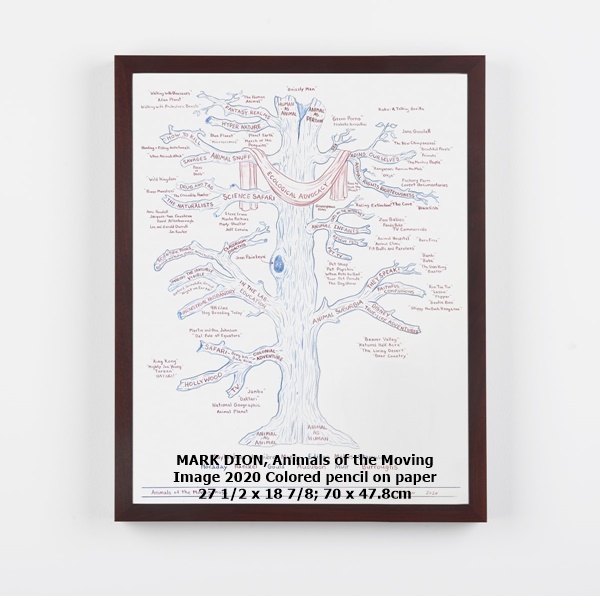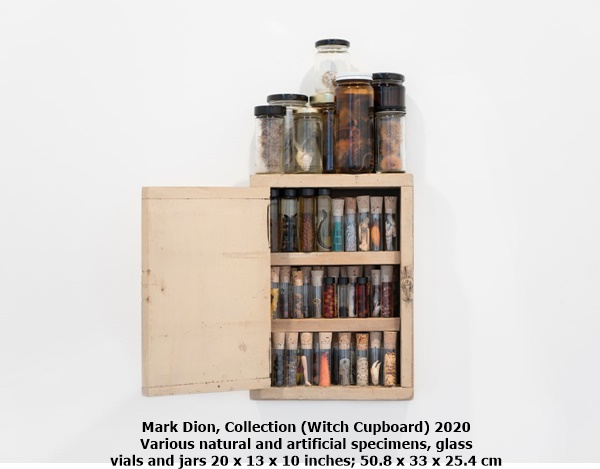Mark Dion

Tanya Bonakdar Gallery
1010 North Highland Avenue Los Angeles, CA 90038t: 323 380 7172 e-mail:


July 31 > August 14, 2020



We are pleased to share an exclusive online presentation of Mark Dion’s newest works, including an in depth look at his drawing practice, a new cabinet of curiosity created during quarantine and an installation displaying a laboratory dedicated to the theory and proliferation of jellyfish.
Since the early 1990s, Dion has developed a remarkably dynamic and influential investigation of the visual representation of history, knowledge and the natural world. Environmental concerns and the effects of industry and human negligence on the natural habitat are just some of the issues that Dion has addressed in depth over the past thirty years, and which seem more poignant now than ever. With an edge of irony, humor and improvisation, the artist deconstructs scientific and museum-based methods of collecting, arranging and exhibiting objects by appropriating and incorporating them critically into his projects and exhibitions.
Dion's newest work, Collection (Witch Cupboard) was created during quarantine in New York. Typically, Dion’s work has a strong connection to the location where he creates or installs his work. For this piece, the artist collected specimens and objects from his own personal collection. This resulted in an autobiographical work, giving the viewer a more intimate look into Dion’s collecting habits. Continuing his interest in subverting the traditional hierarchies and display, Dion juxtaposes objects matchbook cards, bottle caps arranged by color and mice in formaldehyde.
With the limitations of quarantine, Dion has also expanded his drawing practice. Works on paper have always been a critical part of his process, listen and watch the artist create new large scale works in his upstate studio.
Dion’s installation, Lecture - The trouble with Jellyfish presents a laboratory where the theory of these invertebrates and the recent phenomenon of their proliferation is examined. Across the world’s seas, jellyfish blooms of impressive magnitude are signaling ecological disturbances and a dramatic deterioration of the marine environment. While these troubles are beginning to garner public attention, what to do remains unclear. Lecture explores this question and the marine biological challenges associated with jellyfish and degrading ocean biodiversity. In recent years, jellyfish have gained notoriety for wreaking havoc as they multiply en masse—a phenomenon that scientists are still working to understand more fully. Dion’s piece presents a chart which examines this issue, and suggests that human-based ecological disturbances are turning back the clock on the ocean to precambrian times as we take out the vertebrates and replace them with invertebrates.
Since the early 1990s, Dion has developed a remarkably dynamic and influential investigation of the visual representation of history, knowledge and the natural world. Environmental concerns and the effects of industry and human negligence on the natural habitat are just some of the issues that Dion has addressed in depth over the past thirty years, and which seem more poignant now than ever. With an edge of irony, humor and improvisation, the artist deconstructs scientific and museum-based methods of collecting, arranging and exhibiting objects by appropriating and incorporating them critically into his projects and exhibitions.
Dion's newest work, Collection (Witch Cupboard) was created during quarantine in New York. Typically, Dion’s work has a strong connection to the location where he creates or installs his work. For this piece, the artist collected specimens and objects from his own personal collection. This resulted in an autobiographical work, giving the viewer a more intimate look into Dion’s collecting habits. Continuing his interest in subverting the traditional hierarchies and display, Dion juxtaposes objects matchbook cards, bottle caps arranged by color and mice in formaldehyde.
With the limitations of quarantine, Dion has also expanded his drawing practice. Works on paper have always been a critical part of his process, listen and watch the artist create new large scale works in his upstate studio.
Dion’s installation, Lecture - The trouble with Jellyfish presents a laboratory where the theory of these invertebrates and the recent phenomenon of their proliferation is examined. Across the world’s seas, jellyfish blooms of impressive magnitude are signaling ecological disturbances and a dramatic deterioration of the marine environment. While these troubles are beginning to garner public attention, what to do remains unclear. Lecture explores this question and the marine biological challenges associated with jellyfish and degrading ocean biodiversity. In recent years, jellyfish have gained notoriety for wreaking havoc as they multiply en masse—a phenomenon that scientists are still working to understand more fully. Dion’s piece presents a chart which examines this issue, and suggests that human-based ecological disturbances are turning back the clock on the ocean to precambrian times as we take out the vertebrates and replace them with invertebrates.
 |
Mark Dion |
mpefm USA art press release
Online VIEWING ROOM
QR of this press release
in your phone, tablet








